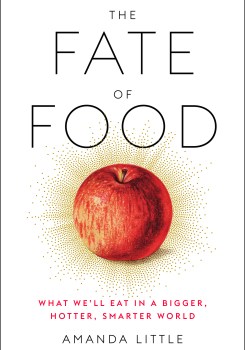Can Robots Influence ‘The Fate Of Food’?
In ‘The Fate of Food’ by Amanda Little, a robot gets its hands dirty in a lettuce field.
The following is an excerpt of The Fate of Food: What We’ll Eat in a Bigger, Hotter, Smarter World by Amanda Little.
Jorge Heraud is in a Californian lettuce field and he’s about to lose his mind. It’s a balmy, cloudless day in April 2014, and Salinas Valley stretches out around him like a Hidden Valley Ranch commercial, its endless rows of emerald lettuce leaves pushing up through the black soil.

The Fate of Food: What We'll Eat in a Bigger, Hotter, Smarter World
Heraud has come here to test “Potato,” a robot that may be the agricultural equivalent of an Apple-1 prototype circa 1977. Its success could shape the future of lettuce farming, and of farming, period. Just as Ruth Oniang’o sees a synergy between old and new forms of agriculture, Heraud shares in this third way thinking, and Potato is evidence of that. Intelligent machines, he believes, are not at odds with sustainable food production, but a means to achieve it.
As Heraud looks on, Potato is trying to perform the seemingly simple task of thinning baby lettuce plants so the hardier ones have space to mature. If you’re imagining, as I was, a C-3PO-style bipedal robot that walks into fields with pincerlike hands to do the yanking, Potato isn’t that. It looks like a huge metal Pez dispenser laid sideways on a rack that’s hitched to the back of a tractor. The bot “sees” the seedlings via cameras mounted to a rack. In milliseconds, it identifies the strongest ones and kills the weaklings with jets of concentrated fertilizer shot through tiny tubes and nozzles.
Or that’s what it’s supposed to do, but Heraud’s prototype is on the fritz. Robots like controlled environments, and Potato’s delicate equipment isn’t responding well to the heat and dust or the tractor’s vibrations. Electrical components are short-circuiting, nozzles are failing, dirt is gumming up the cooling fans, and the PCs aren’t stable. All day long, about every half hour, Potato’s monitors freeze into blue screens of death.
Heraud’s agony deepens as the failures mount. For months, his team has been testing beta cousins of Potato, each with a salad-themed moniker: “Caesar,” “Cobb,” “Chicken,” “Wedge,” “Jell-O.” All are early versions of a product they’ve officially named LettuceBot, which Heraud has prematurely begun leasing to farmers. Two days from now, Heraud has to face his investors at a board meeting. They’ve plowed $13 million into his start-up and they want to hear that he’s got it working already.
Heraud, who is 45, internalizes stress. Lately his skin has been breaking out into prickly rashes; he’s had insomnia and punishing heartburn. LettuceBot isn’t even what he’d originally pitched to them. He’d envisioned a robotic weeder that could perform far more complex tasks and radically reduce the use of agricultural chemicals worldwide. Such a machine would first disrupt the herbicide industry, which is dominated by Syngenta, Bayer, DowDuPont, and Monsanto. It would protect topsoil fertility, support climate-smart practices like “no-till” farming, save countless aquatic and amphibious species, diminish the public health problems stemming from chemical residues in our food, and clean up the world’s waterways. Heraud had named the company Blue River Technology with these lofty goals in mind.
When Heraud confesses his field-test failures to the board, they don’t vote to oust him as he’d feared, but challenge him to turn things around. In the coming months, he and his team of twenty engineers launch a 24/7 troubleshooting offensive they call “the surge.” They take turns sleeping on cots in the closet of their Silicon Valley office. They call in husbands and wives to turn wrenches and clamp tubes. They redesign fans, build mounts, change materials, and reformulate chemicals.
Heraud consumes Tums by the fistful. By late 2015, they have a glitch-free LettuceBot that can handle the elements. They expand their contracts with farmers in Salinas and in Yuma, Arizona, and build more machines. By early 2017, about a fifth of all the lettuce grown in the United States has been thinned by a LettuceBot.
Heraud and his investors are buoyed by the success, but other news excites them more. The microchip company Nvidia has released a computing platform with outsize processing power. It’s designed for navigation in self-driving cars, but it also means that a farming robot, like Heraud had always envisioned, might be able to crunch a lot more data captured by mobile cameras than the current lettuce thinner. It means Heraud’s team may be able to build that weeding robot he’d imagined after all. What Heraud couldn’t possibly have imagined, however, as his team began to cobble together their first dream machine, is that in September 2017 the green-and-yellow tractor company, John Deere, would acquire Blue River for $305 million. And the oldest brand in farming, founded in 1837, will be on board with Heraud’s grand vision—not just of slashing agrochemical applications worldwide, but of transforming food production for good.
Excerpted from The Fate of Food: What We’ll Eat in a Bigger, Hotter, Smarter World. Copyright © 2019 by Amanda Little. Published by Harmony Books, an imprint of Penguin Random House
Amanda Little is the author of The Fate of Food: What We’ll Eat in a Bigger, Hotter, Smarter World, and a professor of Investigative Journalism and Science Writing at Vanderbilt University in Nashville, Tennessee.